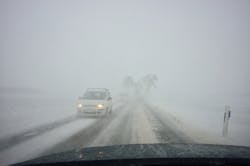Remember These Safe Driving Tips for Holiday and Winter Travel
The American Society of Safety Engineers (ASSE) is offering driving tips to help motorists get to their destinations safely, whether we are driving for work or for leisure. Particularly at this time of year, roads are crowded and weather conditions can be tricky.
“With a predicted 43.6 million people expected to be on the road this Thanksgiving, we urge people to drive safely and be aware of the fact that there are still millions of people on the road as part of their job,” said ASSE Transportation Practice Specialty Administrator Brian S. Hammer. “Transportation incidents continue to be the number one cause of on-the-job deaths in the U.S. today, representing 41 percent of fatal workplace injuries in 2011. Everyone must do their part to prevent these tragedies and make sure everyone has a great holiday.”
Tips for Employers
The National Institute of Occupational Safety and Health (NIOSH) notes that unlike other workplaces, the roadway is not a closed environment. Although employers cannot control roadway conditions, they can promote safe driving by providing safety information to workers, well-maintained vehicles and by setting driver safety policies. To protect their employees, employers can follow these and other safe driving tips:
- Assign a key member of the management team, such as the safety and health professional, responsibility and authority to set and enforce a comprehensive driver safety policy;
- Set and enforce mandatory seatbelt use;
- Don’t require employees to drive irregular hours or far beyond their normal working hours;
- Don’t require workers to conduct business on a cell phone or text while driving;
- Develop work schedules that allow employees to obey speed limits and to follow applicable hours-of-service regulations.
Holiday travelers and employers whose employees drive in areas that experience cold and inclement weather should consider equipping each vehicle with a winter storm kit that includes blankets, a flashlight, cell phone with charger and extra batteries, a shovel, first-aid kit, non-perishable food, extra warm clothes and a water container. Hypothermia is a potentially dangerous exposure during extremely cold winter months. People can suffer from hypothermia when they lose body temperature in cold weather as a result of exposure.
ASSE suggests that all travelers:
- Plan ahead and allow plenty of time to travel, and that businesses maintain information on employee driving destinations, driving routes and estimated time of arrivals;
- Make sure vehicles are winterized. Before driving have a mechanic look at the battery, antifreeze, wipers and windshield washer fluid, ignition system, thermostat, lights, flashing hazard lights, exhaust system, heater, brakes, defroster, tire tread and oil level and carry a windshield scraper for ice and snow removal;
- Check weather conditions from the National Weather Service, which provides weather reports and alerts; and
- Make sure the vehicle has the correct tires for the road conditions.
Surprising Statistics
Despite what we might think, fatal highway accidents don’t just occur during terrible weather conditions or at night. In fact, according to the U.S. Department of Transportation (DOT), statistics show that in 2010, the majority of fatal accidents occurred during normal weather and in the daylight. The DOT statistics show that of the 32,885 people killed in roadway incidents in 2010, 22,902 were male.
ASSE notes some of the leading causes of fatal roadway crashes are failure to keep in the proper lane or running off the road; driving too fast for conditions or in excess of the posted speed limit; driving under the influence; failure to yield the right of way; distracted driving; operating in an erratic/reckless manner; and failure to obey traffic signs and signals.
For holiday motorists, ASSE suggests these additional tips to help increase roadway safety during winter weather travel:
- Remove any snow on your vehicle’s windows, lights, brake lights, roof and signals;
- Check your vehicle’s tires, wiper blades, fluids, lights, belts and hoses;
- Wear a seatbelt and properly restrain children in the back seat of a vehicle;
- Don’t be distracted while driving. Many states prohibit texting while driving. For all drivers, distracted driving is deadly even in good weather. One study showed that 85 percent of crashes occur within 3 seconds of a driver’s distraction; sending a text message while traveling 40 mph can cause your eyes to be off the road for 4.7 to 5.0 seconds, enough time to travel up to 294 feet before you start braking.
- Don’t speed; the faster you’re going, the longer it will take to stop;
- Make sure your vehicle is equipped with the proper tires for the roadway conditions;
- Brake early, brake slowly, brake correctly and never slam on the brakes. If you have anti-lock brakes, press the pedal down firmly and hold it. If you don’t have anti-lock brakes, gently pump the pedal.
- When behind vehicles, the recommended following distance is a minimum of 3 seconds for passenger and light trucks traveling in ideal conditions. When conditions are less than ideal, you should increase the amount of distance between you and the vehicle ahead; and,
- Beware of black ice. Roads that seem dry actually may be slippery and dangerous, so take it slow when approaching intersections, off-ramps, bridges or shady areas.
About the Author

Sandy Smith
Sandy Smith is the former content director of EHS Today, and is currently the EHSQ content & community lead at Intelex Technologies Inc. She has written about occupational safety and health and environmental issues since 1990.
